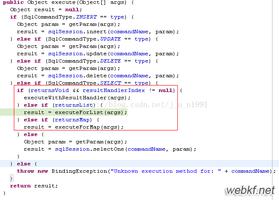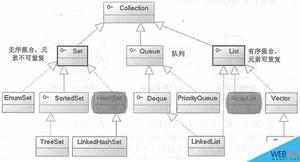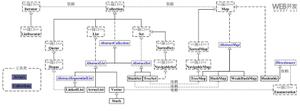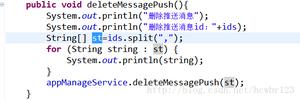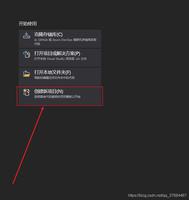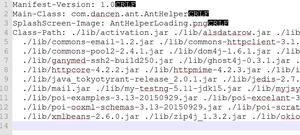Java - Collection

http://blog.csdn.net/itlwc/article/details/10148321
2013-08-21 15:13 4389人阅读 评论(3) 收藏 举报
分类:
版权声明:本文为博主原创文章,未经博主允许不得转载。
目录(?)[+]
Collection层次结构
Collection
[plain] view plain copy
- 子接口
- Set,List
- 集合中只能放置对象的引用,不能放置原生数据类型,
- 我们需要使用原生数据类型的封装类才能加入到集合中
Ordered与Sorted接口
[plain] view plain copy
- Ordered排序,按照某种由具体情况决定的顺序排序,是后天指定的
- Sorted排序,按照天然顺序进行排序,是先天指定的
List
[plain] view plain copy
- 实现类包括
- LinkedList,Vector,ArrayList
- 列表接口,继承与Collection,可以按索引的顺序访问,有索引的Collection
- 具有列表的功能,元素顺序均是按添加的先后进行排列的,
- 允许重复的元素,允许多个null元素
List常用方法
[java] view plain copy
- package com.itlwc;
- import java.util.ArrayList;
- import java.util.List;
- public class Test {
- public static void main(String[] args) {
- List list = new ArrayList();
- // 向列表的尾部追加指定的元素
- list.add("lwc");
- // 在列表的指定位置插入指定元素
- list.add(1, "nxj");
- // 追加指定 collection 中的所有元素到此列表的结尾
- list.addAll(new ArrayList());
- // 从列表中移除所有元素
- list.clear();
- // 如果列表包含指定的元素,则返回true
- list.contains("nxj");
- // 如果列表包含指定 collection 的所有元素,则返回 true
- list.containsAll(new ArrayList());
- // 比较指定的对象与列表是否相等
- list.equals(new ArrayList());
- // 返回列表中指定位置的元素
- list.get(0);
- // 返回列表的哈希码值
- list.hashCode();
- // 返回列表中首次出现指定元素的索引,如果列表不包含此元素,则返回 -1
- list.indexOf("lwc");
- // 返回列表中最后出现指定元素的索引,如果列表不包含此元素,则返回 -1
- list.lastIndexOf("lwc");
- // 如果列表不包含元素,则返回 true
- list.isEmpty();
- // 移除列表中指定位置的元素
- list.remove(0);
- // 移除列表中出现的首个指定元素
- list.remove("lwc");
- // 从列表中移除指定 collection 中包含的所有元素
- list.removeAll(new ArrayList());
- // 用指定元素替换列表中指定位置的元素
- list.set(0, "lp");
- // 返回列表中的元素数
- list.size();
- // 返回列表中指定的fromIndex(包括)和toIndex(不包括)之间的部分视图
- list.subList(1, 2);
- // 返回以正确顺序包含列表中的所有元素的数组
- list.toArray();
- // 返回以正确顺序包含列表中所有元素的数组
- list.toArray(new String[] { "a", "b" });
- }
- }
ArrayList
[plain] view plain copy
- 构造方法
- public ArrayList()
- public ArrayList(int initialCapacity)
- public ArrayList(Collection c)
- ArrayList依赖于数组实现的,初始长度为10的Object[],并且可随需要而增加的动态数组
- 当元素超过10,那么ArrayList底层会新生成一个数组,长度为原来的1.5倍+1,
- 然后将原数组内容复制到新数组中,并且后续增加的内容会放到新数组中,
- 当新数组无法容纳增加的元素,重复该过程
- ArrayList对随机访问性能很好,但进行大量插入,删除操作,性能很差,
- 因为操作之后后续元素需要移动
遍历ArrayList
[java] view plain copy
- package com.itlwc;
- import java.util.ArrayList;
- import java.util.Iterator;
- import java.util.List;
- public class Test {
- public static void main(String[] args) {
- List<String> list = new ArrayList<String>();
- list.add("lwc");
- list.add("nxj");
- // 方法一
- Iterator<String> ite1 = list.iterator();
- while (ite1.hasNext()) {
- String str = ite1.next();
- System.out.println(str);
- }
- System.out.println("---------------------");
- // 方法二(方法一的变形)
- for (Iterator<String> ite2 = list.iterator(); ite2.hasNext();) {
- String str = ite2.next();
- System.out.println(str);
- }
- System.out.println("---------------------");
- // 方法三
- for(String s : list){
- System.out.println(s);
- }
- }
- }
- /*
- 打印结果:
- lwc
- nxj
- ---------------------
- lwc
- nxj
- ---------------------
- lwc
- nxj
- */
Vector
[plain] view plain copy
- 向量,历史比较悠久,Java诞生就有了,特点与ArrayList相同,
- 不同的是Vector操作元素的方法是同步的,同一时刻只能有一个线程访问,没有特殊需求都使用ArrayList
- 构造方法
- public Vector()
- public Vector(int initialCapacity)
- public Vector(int initialCapacity,int capacityIncrement)
- 第一个参数是初始容量,第二个参数是当Vector满时的增量
- public Vector(Collection c)
- Vector也是依赖数组实现的
案例
[java] view plain copy
- package com.itlwc;
- import java.util.Enumeration;
- import java.util.Vector;
- public class Test {
- public static void main(String[] args) {
- Vector v = new Vector();
- v.add("123");
- v.add("lwc");
- v.add("你好");
- // Vector转换为枚举
- Enumeration e = v.elements();
- while (e.hasMoreElements()) {
- System.out.println(e.nextElement());
- }
- }
- }
Stack
[java] view plain copy
- Vector的子类
案例
[java] view plain copy
- package com.itlwc;
- import java.util.Enumeration;
- import java.util.Stack;
- public class Test {
- public static void main(String[] args) {
- Stack stack = new Stack();
- // 向栈里面压一个整数
- stack.push(new Integer(123));
- stack.push("lwc");
- stack.push(new Double(88.88));
- // 遍历
- Enumeration items = stack.elements();
- while (items.hasMoreElements()) {
- System.out.print(items.nextElement() + " ");
- }
- System.out.println();
- // 出栈
- while (stack.size() != 0) {
- System.out.print(stack.pop() + " ");
- }
- }
- }
- /*
- 打印结果:
- 123 lwc 88.88
- 88.88 lwc 123
- */
LinkedList
[plain] view plain copy
- LinkedList功能与ArrayList,Vector相同,内部是依赖双链表实现的,
- 因此有很好的插入和删除性能,但随机访问元素的性能很差
- 构造方法
- public LinkedList()
- public LinkedList(Collection c)
- LinkedList类中有一个Entry内部类,Entry内部类包含3个部分向前的引用,向后的引用,数据
- header.next = header.previous = header;
遍历LinkedList
[java] view plain copy
- package com.itlwc;
- import java.util.LinkedList;
- import java.util.List;
- import java.util.ListIterator;
- public class Test {
- public static void main(String[] args) {
- List link = new LinkedList();
- link.add(123);
- link.add("lwc");
- link.add(8.8);
- link.add("nxj");
- link.add(520);
- printList(link);
- printReversedList(link);
- }
- private static void printList(List link) {
- System.out.println("正序链表中的元素");
- // 的到链表的迭代器,位置指向链头
- ListIterator li = link.listIterator();
- // 判断迭代器中是否有下一个元素
- while (li.hasNext()) {
- // 返回下个元素
- System.out.print(li.next() + " ");
- }
- System.out.println();
- }
- private static void printReversedList(List link) {
- System.out.println("逆向链表中的元素");
- // 的到链表的迭代器,位置指向link.size()结尾
- ListIterator li = link.listIterator(link.size());
- // 判断迭代器中是否有前一个元素
- while (li.hasPrevious()) {
- // 返回前一个元素
- System.out.print(li.previous() + " ");
- }
- System.out.println();
- }
- }
- /*
- 打印结果:
- 正序链表中的元素
- 123 lwc 8.8 nxj 520
- 逆向链表中的元素
- 520 nxj 8.8 lwc 123
- */
自定义LinkedList结构
[java] view plain copy
- package com.itlwc;
- class Node {
- Node previous;// 前驱
- String data;// 数据
- Node next;// 后驱
- public Node(String data) {
- this.data = data;
- }
- }
- public class Test {
- public static void main(String[] args) {
- Node node1 = new Node("node1");
- Node node2 = new Node("node2");
- Node node3 = new Node("node3");
- node1.next = node2;
- node2.previous = node1;
- node2.next = node3;
- node3.previous = node2;
- node3.next = node1;
- node1.previous = node3;
- // 增加node4
- Node node4 = new Node("node4");
- node1.next = node4;
- node4.previous = node1;
- node4.next = node2;
- node2.previous = node4;
- // 删除node4
- node1.next = node2;
- node2.previous = node1;
- node4.previous = null;
- node4.next = null;
- }
- }
依赖倒置原理
[plain] view plain copy
- 依赖应该尽量在抽象层进行,避免在具体层进行,
- 在实际开发中尽量使用接口类型的引用,避免采用具体类型的引用
案例
[java] view plain copy
- package com.itlwc;
- import java.util.LinkedList;
- import java.util.List;
- public class Test {
- //如果我们需要传入参数是ArrayList就需要改动代码
- public void printLinkedList(LinkedList ll){
- System.out.println(ll);
- }
- //如果我们传入参数是List的子类,我们不需要改动代码,灵活性大
- public void printList(List l){
- System.out.println(l);
- }
- }
将数组转换为列表
[java] view plain copy
- package com.itlwc;
- import java.util.Arrays;
- import java.util.List;
- public class Test {
- public static void main(String[] args) {
- String[] str = { "l", "w", "c" };
- //使用Java类库中java.util.Arrays类的静态方法asList()
- List l = Arrays.asList(str);
- System.out.println(str);
- }
- }
- /*
- 打印结果:
- [l, w, c]
- */
ArrayList VS LinkedList
[plain] view plain copy
- ArrayList底层采用数组实现,LinkedList底层采用双链表实现
- 如果为列表增加对象
- ArrayList是ArrayList底层数组维护的,LinkedList是LinkedList底层Entry对象维护的
- LinkedList底层Entry结构
- Entry{
- Entry previous;
- Object element;
- Entry next;
- }
- 其中element就是我们添加的元素,最后将生成的Entry对象加入到链表中
- 插入和删除操作时,采用LinkedList好,搜索时,采用ArrayList好
List<Map>遍历
[java] view plain copy
- package com.itlwc;
- import java.util.ArrayList;
- import java.util.HashMap;
- import java.util.Iterator;
- import java.util.List;
- import java.util.Map;
- public class Test {
- public static void main(String[] args) {
- Map<Integer, String> map1 = new HashMap<Integer, String>();
- map1.put(new Integer(1), "lwc");
- map1.put(new Integer(2), "nxj");
- Map<Integer, String> map2 = new HashMap<Integer, String>();
- map2.put(new Integer(3), "tom");
- map2.put(new Integer(4), "cat");
- List<Map<Integer, String>> list = new ArrayList<Map<Integer, String>>();
- list.add(map1);
- list.add(map2);
- // 方法一
- Iterator<Map<Integer, String>> ite1 = list.iterator();
- while (ite1.hasNext()) {
- Map<Integer, String> m = ite1.next();
- System.out.println(m);
- }
- System.out.println("-----------------------------");
- // 方法二(方法一的变形)
- for (Iterator<Map<Integer, String>> ite2 = list.iterator(); ite2.hasNext();) {
- Map<Integer, String> m = ite2.next();
- System.out.println(m);
- }
- System.out.println("-----------------------------");
- // 方法三:
- for (Map<Integer, String> m : list) {
- System.out.println(m);
- }
- }
- }
- /*
- 打印结果:
- {1=lwc, 2=nxj}
- {3=tom, 4=cat}
- -----------------------------
- {1=lwc, 2=nxj}
- {3=tom, 4=cat}
- -----------------------------
- {1=lwc, 2=nxj}
- {3=tom, 4=cat}
- */
Set
[plain] view plain copy
- 实现类
- HashSet,LinkedHashSet
- 子接口
- SortSet
- 实现类
- TreeSet
- 不包含重复元素,最多包含一个null,元素没有顺序
HashSet
[plain] view plain copy
- HashSet不是Ordered也不是Sorted,存储对象引用时是按照哈希策略来实现的,
- HashSet中是否存在一个对象是通过equals()和hashCode()协同判断
- 不保证顺序
- 构造方法
- public HashSet()
- public HashSet(int initialCapacity)
- public HashSet(Collection c)
- HashSet底层是使用HashMap实现的
- HashSet的add()方法详解:
- 判断已经存储在集合中的对象hashCode值是否与增加对象的hashCode值一致
- 如果不一致,直接加进去
- 如果一致,再进行equals()比较
- 如果equals()返回true,对象已经存在不增加进去
- 如果equals()返回false,把对象增加进去
LinkedHashSet
[plain] view plain copy
- LinkedHashSet是Ordered,采用双链表实现的
- 有固定顺序,也就是插入顺序
- LinkedHashSet底层是使用LinkedHashMap实现的
- 构造方法
- public LinkedHashSet()
- public LinkedHashSet(int initialCapacity)
- public LinkedHashSet(Collection c)
SortedSet接口
[plain] view plain copy
- 保证迭代器按照元素递增顺序遍历的集合,可以按照元素的自然顺序进行排序
- 常用方法
- Object first()
- 返回此有序集合中当前第一个(最小的)元素
- Object last()
- 返回此有序集合中最后一个(最大的)元素
- SortedSet headSet(Object toElement)
- 返回此有序集合的部分视图,其元素严格小于toElement
- SortedSet tailSet(Object fromElement)
- 返回此有序集合的部分视图,其元素大于或等于fromElement
- SortedSet subSet(Object fromElement,Object toElement)
- 返回此有序集合的部分视图,元素范围从fromElement(包括)到toElement(不包括)
- Comparator comparator()
- 返回与此有序集合关联的比较器,如果使用元素的自然顺序,则返回 null
TreeSet
[java] view plain copy
- TreeSet是SortedSet接口的实现,元素不论以什么元素插入,在遍历的时候,都会以天然顺序遍历
- TreeSet底层是使用TreeMap实现的
- 构造方法
- public TreeSet()
- public TreeSet(SortedSet s)
- public TreeSet(int initialCapacity)
- public TreeSet(Comparator<? super E>)
- public TreeSet(Collection c)
- 因为TreeSet是带排序的,所以想要为TreeSet增加自定义类型,必须指定排序规则
TreeSet排序规则Comparator案例
[java] view plain copy
- package com.itlwc;
- import java.util.Comparator;
- import java.util.Iterator;
- import java.util.TreeSet;
- public class Test {
- public static void main(String[] args) {
- TreeSet set = new TreeSet(new PersonComparator());
- set.add(new Person("lwc", 80));
- set.add(new Person("nxj", 70));
- set.add(new Person("lp", 60));
- set.add(new Person("fy", 75));
- Iterator ite = set.iterator();
- while (ite.hasNext()) {
- Person p = (Person)ite.next();
- System.out.println(p.name);
- }
- }
- }
- class Person {
- String name;
- int score;
- public Person(String name, int score) {
- this.name = name;
- this.score = score;
- }
- }
- class PersonComparator implements Comparator {
- public int compare(Object o1, Object o2) {
- Person p1 = (Person) o1;
- Person p2 = (Person) o2;
- return p1.score - p2.score;
- }
- }
Collections
[plain] view plain copy
- 操作Collection类的工具类,类中方法都是静态的
Collections常用方法
[java] view plain copy
- package com.itlwc;
- import java.util.ArrayList;
- import java.util.Collections;
- import java.util.Comparator;
- public class Test {
- public static void main(String[] args) {
- // 将所有元素从一个列表复制到另一个列表
- Collections.copy(new ArrayList(), new ArrayList());
- // 如果两个指定collection中没有相同的元素,则返回 true
- Collections.disjoint(new ArrayList(), new ArrayList());
- // 使用指定元素替换指定列表中的所有元素
- Collections.fill(new ArrayList(), new Object());
- // 返回指定 collection 中等于指定对象的元素数
- Collections.frequency(new ArrayList(), new Object());
- // 返回指定源列表中第一次出现指定目标列表的起始位置,如果没有出现这样的列表,则返回 -1
- Collections.indexOfSubList(new ArrayList(), new ArrayList());
- // 根据元素的自然顺序,返回给定 collection 的最大元素
- Collections.max(new ArrayList());
- // //根据元素的自然顺序,返回给定 collection 的最大元素
- Collections.min(new ArrayList());
- // 使用另一个值替换列表中出现的所有某一指定值
- Collections.replaceAll(new ArrayList(), "oldVal", "newVal");
- // 反转指定列表中元素的顺序
- Collections.reverse(new ArrayList());
- // 返回一个比较器,它强行反转
- Collections.reverseOrder();
- // 返回一个比较器,它强行反转指定比较器的顺序
- Collections.reverseOrder(new Comparator() {
- @Override
- public int compare(Object o1, Object o2) {
- return 0;
- }
- });
- // 使用默认随机源随机更改指定列表的序列
- Collections.shuffle(new ArrayList());
- // 根据元素的自然顺序对指定列表按升序进行排序
- Collections.sort(new ArrayList());
- // 根据元素的自然顺序对指定列表按降序进行排序
- Collections.sort(new ArrayList(), Collections.reverseOrder());
- // 在指定列表的指定位置处交换元素
- Collections.swap(new ArrayList(), 1, 2);
- }
- }
以上是 Java - Collection 的全部内容, 来源链接: utcz.com/z/394705.html

